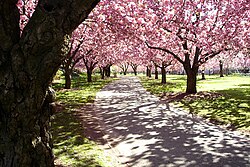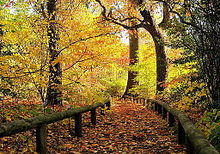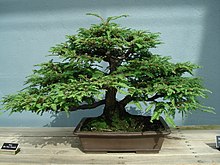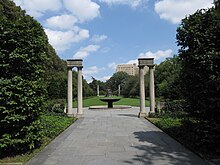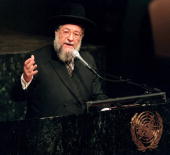Brooklyn Botanic Garden (BBG) is a botanical garden in the borough of Brooklyn in New York City. Founded in 1910 and located in the Prospect Park neighborhood, the 52-acre (21 ha) garden includes a number of specialty “gardens within the Garden,” plant collections, and the Steinhardt Conservatory, which houses the C.V. Starr Bonsai Museum, three climate-themed plant pavilions, a white cast-iron and glass aquatic plant house, and an art gallery. The Garden holds over 10,000 taxa of plants and each year welcomes over 900,000 visitors from around the world.
Early plans for Prospect Park originally called for the park to straddle Flatbush Avenue. The City of Brooklyn purchased the land for this purpose in 1864.[1] When Frederick Law Olmsted and Calvert Vaux brought their final plans to the city for approval in the 1860s, they had eliminated the problematic division along Flatbush. The northeast portion went unused, serving as an ash dump. Legislation in 1897 as the city moved toward consolidation reserved 39 acres (16 ha) for a botanic garden, and the garden itself was founded in 1910.[2] The garden was initially known as the Institute Park. It was run under the auspices of the Brooklyn Institute of Arts and Sciences, which included (until the 1970s) the Brooklyn Museum, Brooklyn Children’s Museum, and Brooklyn Academy of Music.[3] It opened as the Brooklyn Botanic Garden on May 13, 1911, with the Native Flora Garden being the first established section.[1]
Harold Caparn was appointed as the landscape architect in 1912. Caparn designed most of the rest of the grounds over the next three decades, including the Osborne Garden, Cranford Rose Garden, Magnolia Plaza, and Plant Collection.[4] Construction of the Laboratory Building and Conservatory began in 1912, and the building was dedicated in 1917.[1]The building—now simply the Administration Building—was designed in the Tuscan Revival style by William Kendall for McKim, Mead & White, the architectural firm that built the Brooklyn Museum, Manhattan Municipal Building, and many other prominent New York City buildings. It was designated a New York City Landmark in 2007.[5]
Specialty gardens and collections
Cherry Trees
The Garden has more than 200 cherry trees of forty-two Asian species and cultivated varieties, making it one of the foremost cherry-viewing sites outside of Japan. The first cherries were planted at the garden after World War I, a gift from the Japanese government. Each spring at BBG, when the trees are in bloom, a month-long cherry blossom viewing festival called Hanami is held at the Cherry Esplanade, culminating in a weekend celebration called Sakura Matsuri. The Esplanade features two rows of cherry trees with trails and sitting areas on the side. Visitors are also welcome to sit on the field of grass between the rows of cherry trees. Cherry trees are found on the Cherry Esplanade and Cherry Walk, in the Japanese Hill-and-Pond Garden, and in many other locations in the Garden. Depending on weather conditions, the Asian flowering cherries bloom from late March or early April to mid-May. The many different species bloom at slightly different times, and the sequence is tracked online at Cherry Watch, on the BBG website.
The Japanese Hill-and-Pond Garden

Japanese Hill-and-Pond Garden
BBG’s Japanese Hill-and-Pond Garden was the first Japanese garden to be created in an American public garden. It was constructed in 1914 and 1915 at a cost of $13,000, a gift of early BBG benefactor and trustee Alfred T. White, and it first opened to the public in June 1915. Widely considered by numerous landscape architects, to be the masterpiece of its creator, Japanese landscape designer Takeo Shiota (1881–1943). Shiota was born in a small Japanese village about 40 miles (64 km) from Tokyo, and in his youth spent years traversing Japan on foot to explore its natural landscape. He emigrated to the United States in 1907.
The garden is a blend of the ancient hill-and-pond style and the more modern stroll-garden style, in which various landscape features are gradually revealed along winding paths. Its 3 acres (1.2 ha) contain hills, a waterfall, a pond, and an island, all artificially constructed. Carefully placed rocks also play leading roles. Among the architectural elements of the garden are wooden bridges, stone lanterns, a viewing pavilion, a torii or gateway, and a Shinto shrine. The pond is filled with hundreds of Japanese koi fish that visitors can enjoy viewing on the tori or along the trail of the garden. Another element that can be discovered walking through the trail is a Japanese temple dedicated to the wolf spirits. A restoration of the garden in 2000 was recognized with the New York Landmark Conservancy’s 2001 Preservation Award.[citation needed]
The Cranford Rose Garden
In 1927, Walter V. Cranford, a construction engineer whose firm built many of Brooklyn’s subway tunnels, donated $15,000 to BBG for a rose garden. Excavation revealed an old cobblestone road two feet below the surface and tons of glacial rock, which had to be carted away on horse-drawn barges.
The Cranford Rose Garden opened in June 1928. It was designed by Harold Caparn, a landscape architect, and Montague Free, the Garden’s horticulturist. Many of the original plants are still in the garden today. There are over 5,000 bushes of nearly 1,400 kinds of roses, including wild species, old garden roses, hybrid tea roses, grandifloras, floribundas, polyanthas, hybrid perpetuals, climbers, ramblers, and miniature roses. The garden also features a stone statue.
The Native Flora Garden

Native Flora Garden Expansion
The Native Flora Garden was the first section of the garden to be established and opened in 1911.[1] It was the first of its kind in North America. Originally a wildflower planting, it was redesigned in 1931 as a woodland habitat featuring plants native to the New York metropolitan area.[6]The Native Flora Garden closed from 1963 to 1983 due to a lack of funding.
The Native Flora Garden was expanded in 2013 with a new landscape designed by Darrel Morrison. The expansion provides new habitats for local plants that would be shaded out by the mature canopy in the original two-acre garden. The expansion features a tallgrass prairie, dry meadow, pine barrens, kettle pond, and wooden bridge that allows visitors to cross over to the different habitats.[7]
The Shakespeare Garden
A donation from Henry Clay Folger, founder of the Folger Shakespeare Library in Washington, D.C. paved the way for the construction of BBG’s original Shakespeare Garden in 1925. Since moved to a different location in the Garden, this English cottage garden exhibits more than 80 plants mentioned in William Shakespeare‘s plays and poems. Plant labels give the plants’ common or Shakespearean names, their botanical names, relevant quotations, and, in some cases, a graphic representation of the plant.
The Alice Recknagel Ireys Fragrance Garden
Next to the Shakespeare Garden is the Fragrance Garden, complete with braille information signs for visitors with vision disabilities. Created in 1955 by landscape architect Alice Recknagel Ireys, this was the first garden in the country designed for the vision-impaired. All visitors are encouraged to rub the fragrant or pleasingly textured leaves of the plants between their fingers. There are four sections in the garden, each with a theme: (1) plants to touch, (2) plants with scented leaves, (3) plants with fragrant flowers, and (4) kitchen herbs. The garden is wheelchair-accessible, and all planting beds are at an appropriate height for people in wheelchairs. A fountain provides a calming sound and a place to wash one’s hands after touching the various plants.
The Children’s Garden
The BBG Children’s Garden is the oldest continually operating children’s garden within a botanic garden in the world.[citation needed] It was opened in 1914 under the direction of BBG educator Ellen Eddy Shaw and operates as a community garden for children, with hundreds of children registering each year for plots on the 1-acre (0.40 ha) site. This Children’s Garden is also open for GAP interns who get an allocated plot in which they can grow all kinds of vegetables and flowers to harvest later on in the year. The Children’s Garden also has a compost area which is maintained by the GAP interns and staff. The BBG Children’s Garden has served as a model for similar gardens around the world.[citation needed]
Other gardens

A Nymphaea ‘Peach Glow’ water-lily in one of the lily pools
Other specialty gardens at BBG include: the Discovery Garden, designed for young children; the Herb Garden; the Lily Pool Terrace, which includes two large display pools of lilies and koi fish and surrounded by annual and perennial borders; the Osborne Garden, a 3-acre (1.2 ha), Italian-style garden that features pergolas and a stone fountain, and the Rock Garden, built around 18 boulders left behind by the glacier during the Ice Age. A Celebrity Path honors famous Brooklynites past and present, such as Barbra Streisand, Woody Allen, and Walt Whitman, with a trail of engraved paving stones. Following along that path leads to the Alfred T. White Amphitheater that hosts mini concerts and performances.
The Plant Family Collection, which takes about a third of BBG’s total area, includes plants and trees arranged by family to show their evolutionary progression from most primitive to most recently evolved. Although recent studies of plant genetics have changed classification of individual plants, the groupings are still an excellent introduction to the many different plant families and their constituent species. The groupings include primitive plants (ferns and conifers) and composite plants.

Steinhardt Conservatory desert collection
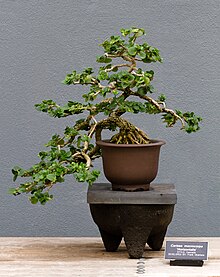
Bonsaï Carissa macrocarpa var. Horizontalis – BBG
The Steinhardt Conservatory houses BBG’s extensive indoor plant collection in three climate-controlled pavilions for tropical, warm temperate, and desert floras. Also located here are: the C.V. Starr Bonsai Museum, one of the oldest collections of dwarfed, potted trees in the country; an art gallery for changing art exhibitions; the Robert W. Wilson Aquatic House, with its collections of tropical water plants, insect-eating plants, and orchids; and the Stephen K-M. Tim Trail of Evolution, which traces the history of plant evolution and the effects of climate change over 3½ billion years.
The Garden also has an Overlook above the Cherry Esplanade that allows visitors to get a holistic view to of the Cherry Esplanade and Garden. The Overlook is also a great place for bird watching or observing other wildlife at the Garden.
Programs
Education programs
Less apparent to the casual visitor are BBG’s diverse programs in youth education, conservation, and community horticulture.
The Garden’s Education department runs a full range of adult and children’s classes and events, and also educates thousands of school and camp groups throughout the year.
Brooklyn Botanic Garden is a founding partner of the Brooklyn Academy of Science and the Environment (BASE), a small public high school dedicated to science, environmental studies, and urban ecology that was launched in 2003. A Field Studies course is offered adjunct Living Environment for incoming freshmen where students spend two hours out of one day in the week at BBG developing scientific skills and immersed in outdoor scientific study. The school is operated by a partnership between BBG, Prospect Park Alliance, and the New York City Department of Education. Students are also connected with scientists and horticulturists who serve as mentors for advanced research studies students develop. BASE graduated its first class in 2007 and has attained its fourth Gates Millennium Scholar in 2013.
BBG’s Garden Apprentice Program (GAP) provides internships for students in grades 8 through 12 in gardening, science education, and environmental issues. The program offers students training and volunteer placements with increasing levels of responsibility for up to four years. Many interns are hired for employment after completing the four year program.
The Discovery Garden hosts weekly hands-on workshops for kids of all ages. The Garden features many interactive exhibits along with a mini plot that has a variety of vegetables that kids can pick and enjoy the fresh treats available. The Garden is currently under construction for expansion.
Project Green Reach is a science-focused school outreach program which annually reaches nearly 2,500 students and teachers in public and nonpublic schools in underserved neighborhoods.
Plant science and conservation
Between 1990 and 2010, Scientists at Brooklyn Botanic Garden made a comprehensive study of the plants of metropolitan New York, called the New York Metropolitan Flora project, or NYMF. The purpose of NYMF is to catalog and describe all vascular plants growing in the region.
The BBG Herbarium collection comprises over 300,000 specimens of preserved plants, particularly plants from the New York metropolitan area. These specimens, some from as early as 1818, create a historical record and aid scientists in tracking species, analyzing the spread of invasive plants, and modeling changes in the metro region’s vegetation. There are also holdings from the western United States, the Galapagos Islands, Bolivia, and Mauritius.
Housed in the McKim, Mead & White Administration Building, the BBG Library provides a collection of books on horticulture and botany that is available to home gardeners, professionals and staff. This building houses a Rare Book Room which holds valuable and historic botanical literature. This building also features classrooms, auditorium, a rotunda and offices.
GreenBridge, the community horticulture program of the Brooklyn Botanic Garden, shares BBG’s knowledge and resources with Brooklyn neighborhoods by offering residential and commercial gardening programs to block associations, community gardens, community centers, and other groups.
The annual Greenest Block in Brooklyn contest encourages neighborhood beautification by offering classes in planting window boxes, planters, and tree pits and recognizing outstanding efforts.
The Urban Composting Project, supported by the New York City Department of Sanitation, offers composting assistance and resources to community gardens and institutions and information on composting in residential backyards to individuals.
Information
Garden publications
BBG has been producing publications since 1945, when it launched America’s first series of popular gardening handbooks. Today, the Brooklyn Botanic Garden Guides to a Greener Planet continue to provide home gardeners with practical information on subjects such as garden design, great plants, and gardening techniques. BBG’s website showcases the Garden and its programs and offers information for the home gardener in popular features such as Garden Botany and Environmental Gardening. New features are added every week, including seasonal interactive guides such as “ID Your Holiday Tree” and “Cherry Watch,” and online resources like the Metropolitan Plant Encyclopedia. BBG’s collection of historic photographs and lantern slides was recently made available online. The website was one of the first to be fully compliant with federal laws requiring information technology to be equally accessible to the disabled.[citation needed]
Visitor information and gardening resources
BBG has two gift shops, a Visitor Center,[8] and a Gardener’s Resource Center which provides reference services to home gardeners, staff, and the professional horticultural community. The Visitor Center and Gardener’s Resource Center are both located in the McKim, Mead and WhiteAdministration Building.
A new Visitor Center at the BBG designed by Weiss/Manfredi opened on May 16, 2012,.[9][10] The Center has a LEED Gold certification for its sustainable and environmental features. The Center features a green roof, geothermal wells, rainwater harvesting and recycled wooden panel in its event space.
The Palm House, a Beaux Arts-style conservatory, is a wedding and events venue offering catering for up to 300 guests. Group tours are also available. Adjacent to the Palm House is the Terrace cafe that offers fresh, daily selections of meals and treats for visitors. During the winter month the cafe is relocated indoors at the lower level of the Steinhardt Conservatory.
BBG has about 165 full-time and 90 part-time employees along with 600 volunteers. Its annual operating budget is $16.2 million.
Signs and plaques
- The boundary line between the City of Brooklyn and the Township of Flatbush can be found in the park. The Brass Marker from 1934 describes the spot and reads “This brass line in the walk shows the boundary between the old City of Brooklyn and the Township of Flatbush.”
- Sandstone Boulder plaque reads, “Boulder of sandstone geological age, Triassic. Transported by continental glacier during the ice age from near Paterson NJ.
- Diabase Boulder plaque reads, “Boulder of Diabase geological age, Triassic. Transported by continental glacier during the ice age from near Haverstraw, NY.
- At the entrance to the park is a sign, “This gate and booth are due to a bequest of Sidney Maddock, 1937″
- In the Japanese garden there is a stone lantern plaque which reads “This Japanese lantern was presented to the city of New York by Mr. Bunj Sakuma a controller of Taito Ward Tokyo, in October 1980, to commemorate the 20th anniversary of the New York-Tokyo sister city affiliation. In 1652, feudal lord Naito Bunzen-no Kami Nobuteru dedicated this 10 foot high, 3 ton, komatsu stone lantern to the Tokugawa shogunate.”
- The Liberty Oaks Memorial is a line of oak trees and a 9/11 memorial. The boulder at the start of the line reads – “In Remembrance Of The Events Of September 11, 2001 And To Those Who Lost Their Lives That Day. The Norway Maples That Grew As The First Generation Of Trees On This Site Were Planted In November 1918 To Commemorate The WW1 Armistice.”
See also
References
External links









































































































